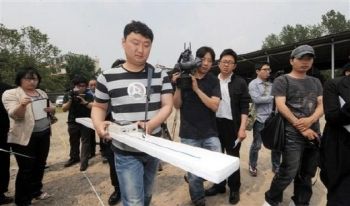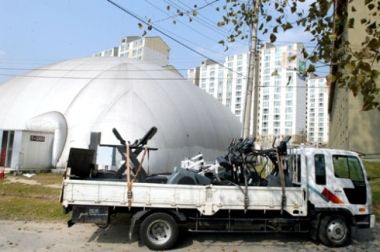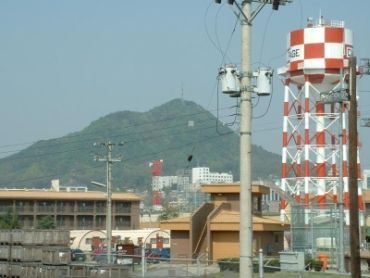
Publisher:
Bonnie King
CONTACT:
Newsroom@Salem-news.com
Advertising:
Adsales@Salem-news.com

~Truth~
~Justice~
~Peace~
TJP
Jun-05-2011 21:27

 TweetFollow @OregonNews
TweetFollow @OregonNews
Report Reveals Toxic Pollution at Numerous US Bases in Korea
Nam Jong-young The Hankyoreh Special to Salem-News.comConducted in 2007, study findings were not disclosed to the public due to the SOFA
 Joint investigation team conducting Electromagnetic Sensing Survey at Camp Mercer. (Photo pool) |
(SEOUL, South Korea) - Forward by Salem-News.com Editor: This summer will mark three years of Salem-News reports involving the rampant contamination of American military bases. While our efforts have mainly concentrated on the now-closed MCAS El Toro Air Station in California and Camp Lejeune, an active Marine Corps base in North Carolina, it has become increasingly clear that all Marine bases are probably toxic, as well as Navy bases like NAS Atsugi in Japan which has been the focus of one article here.
Once again, the toxic culprits appear to be the same, and this time we learn that a political agreement between the U.S. and South Korea has delayed public awareness of the extent of this contamination until now. The American industrial military complex carries a unique ability to inflict damage to a population without firing a single shot. We can only wonder about the moral structures of the Americans that caused this and then blocked it from public view until now. - Tim King
____________________________________
Analysis of an environmental contamination report obtained by the Hankyoreh on Tuesday of 22 U.S. military bases returned to South Korea showed the discovery of high concentrations of materials such as phenol, a toxic material that can cause organ damage, and benzene, a carcinogen, at some of the bases.
Oil pollution was discovered in the soil at 21 of the sites, the only exception being the Yongsan heliport. Inclusion of soil contaminated with heavy metals brought the area of contamination to roughly 25 times that of Seoul Plaza.
Prior to the bases’ return to South Korea, the Ministry of Environment conducted a thorough environmental pollution survey in 2007 on 22 bases and lots, including Camp Page in Chuncheon and the Maehyangri firing range in Hwaseong.
Controversy ensued when the report on its findings was not revealed to the public due to the Status of Forces Agreement (SOFA) between South Korea and the United States. Some of the information was disclosed in the process, but this marks the first time the entire report has been obtained and analyzed.
 Camp Kyle in Uijeongbu closed in '05, learn more: Stars & Stripes |
Analysis of the overall report found many instances in which soil was compromised by oil and chemicals such as cleaning fluid, as well as subsequent contamination of underground water. A layer of oil 4.8 meters thick was found in underground water at Camp Kyle in Uijeongbu, as oil spilled on the soil permeated through to the underground water stratum.
Kangwon National University Geology Professor Lee Jin-yong said, “This is equivalent to the oil pollution from a large petroleum refinery.”
Total petroleum hydrocarbons (TPH) in underground water at Camp Gray in Seoul’s Daebang neighborhood were detected at 2884mg/L, some 1,923 times the public water standard of 1.5mg/L.
Other toxic materials were also detected. Phenol was found at 71 times the standard public water level of 0.005 mg/L at Camp Howes in Paju, and also exceeded standard levels at Camp Edwards and Camp Greaves in Paju and Camp Essayons in Uijeongbu. Phenol is a toxic material that causes dizziness and damage to nerves and organs.
Carcinogenic benzene was detected at over 21 times standard public water levels at Camp Greaves. The report expressed concerns that benzene “might spread outside the investigation area within the next year and enter surrounding farmland.”
 PCE (Perchloroethylene) contaminates Camp Page in South Korea |
At Camp Page, highly carcinogenic PCE was found at 2.7 times standard levels.
Soil contamination, a precursor of underground water contamination, was found to be widespread. Some two-fifths of the total area of Camp Kyle was found to be contaminated with oil and heavy metals. Contamination with heavy metals such as lead and cadmium was found to be severe at Camp Howes and Camp Falling Water in Uijeongbu and the Joint Security Area in Panmunjeom.
At Camp Colbern in Hanam, some 2,450 square meters of construction waste was found buried haphazardly. A full 332,006 square meters was determined to have this type of soil contamination. According to the Soil Environmental Conservation Act, it is not possible to farm or build schools or parks on these sites.
Green Korea Peace Action Bureau head Chung In-chul said, “Since the scale of bases examined was so small, the contaminated area will increase further when other large-scale bases are included.”
Reports on six bases, including Camp Stanton in Paju, warned that contaminated underground water would spread outside the base within one to two years. No immediate measures were taken in response, with cleanup efforts only beginning in 2007.
“Since measures to check the spread of contamination were not carried out immediately, there is a strong chance that additional contamination took place,” said Lee Jin-yong.
First published here: Report reveals toxic pollution at numerous USFK bases by Nam Jong-young - The Hankyoreh
Special thanks to Nam Jong-young and The Hankyoreh for authorizing Salem-News.com to republish this article in the U.S. Please direct questions or comments to englishhani@hani.co.kr
Articles for June 4, 2011 | Articles for June 5, 2011 | Articles for June 6, 2011
Salem-News.com:





Terms of Service | Privacy Policy
All comments and messages are approved by people and self promotional links or unacceptable comments are denied.
Ominous June 16, 2011 4:08 am (Pacific time)
The dry cleaning fluid at Camp Page probably came from up the hill. THE CITY OF CHUN CHON
[Return to Top]©2025 Salem-News.com. All opinions expressed in this article are those of the author and do not necessarily reflect those of Salem-News.com.